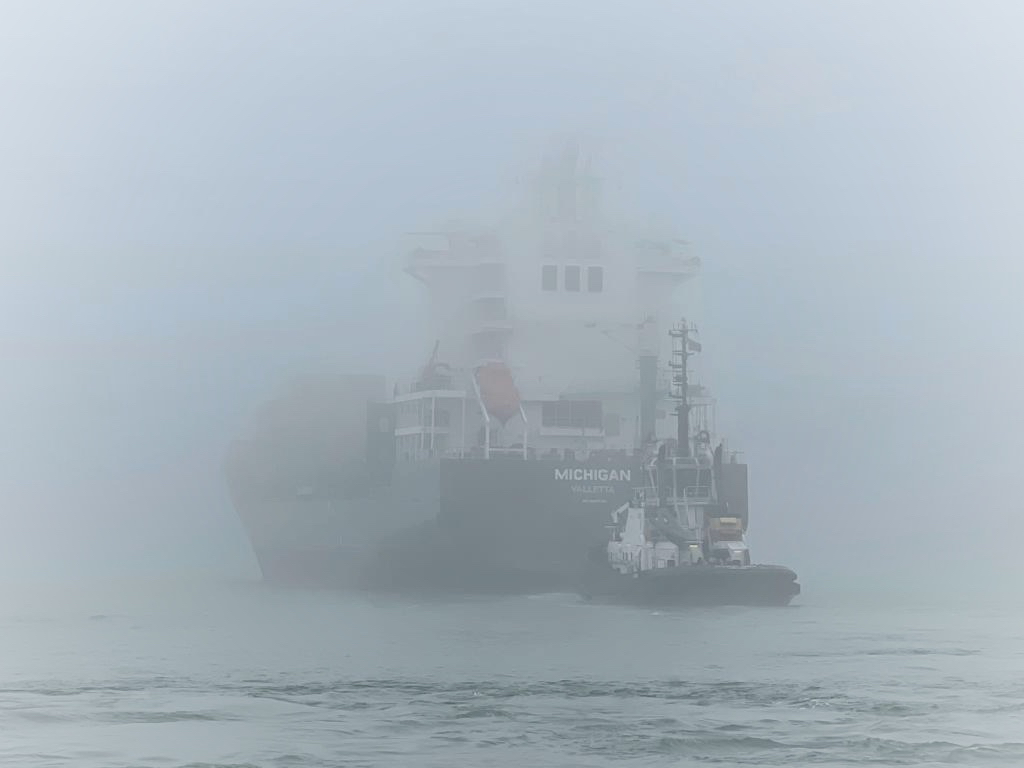To Work in the Fog

Those who navigated amid dense fog banks in the open sea have experienced the sensation of being without the vital sense of sight. Nowadays, technology helps a lot. We will talk about it; however, suddenly, finding ourselves blind leads us to sharpen the remaining basic senses and activate correct countermeasures to reduce the associated risks.
In Port, in some ways, the situation is even more problematic. If, on the one hand, it is undeniable that the fog in the open sea seems denser and the speeds of the moving ships are generally more remarkable, in Port, the room for manoeuvre shrinks, the time reduces, and the dangers multiply.
Navigation, already tricky when it involves other services, such as towing, requires a careful assessment that it can make in advance or during manoeuvring development. But, as we all know, fog can suddenly come with little warning.
The pilot loses the view of the tug and tug’s master, although the availability of the radar loses the orientation concerning the vessel heading.
It is evident that in poor visibility conditions, the movements of ships in the Port should be suspended. However, the pitfall of fog is that of appearing suddenly and that varying in intensity over time. What is true in one area of the Port may not be accurate in another; what is true at a given moment can suddenly change in another, and so on.
Visibility often worsens during the execution of a manoeuvre. We are often called to find the safest way to handle the ship to the assigned berth or accompany it out of the Port. It was not possible to discuss this before. No strategy.
We must act to find the safest way for the ship, its crew and all the actors involved.
As mentioned, efficient radar-ARPA, satellite, ECDIS, and AIS technology come to our aid. Still, above all, PPU (Pilot Portable Unit) allow us to navigate with a certain degree of safety. Still, when we have made fast or are about to secure one or more tugs, we must evaluate and share the operational choices we will make with both the ship’s and the tug’s captains.
In case of dense fog with the ship entering the harbour and with tugboats about to be secured:
- It is necessary to reduce the speed to the minimum possible, stop the engines if required, and allow the fore tug to approach the towing operations safely. The good practice of making fast the aft tug first in fog can reduce speed while maintaining minimum engine ahead for steering.
- Inform the assisting tugs of any order given to the engine and course changing to assess the headway and the relative speed increase.
- The ship’s speed is critical for the fore tug, both in the approach phase for mooring operations and during navigation secured to the vessel. For this reason, it is possible to proceed with the engine stopped, keeping heading with the pull of the fore tug and steering with the action of the stern tugboat.
- Stopping the engine during the stern towline releasing procedure helps prevent the towline from fouling by the ship or tug’s propeller.
- Finally, it is to be considered the use of the ship’s line since the tug crew will quickly release it in a critical situation.
Ultimately, manoeuvring in poor visibility conditions implies great attention to lowering the risk to an acceptable level for all involved. Therefore, it is necessary to implement, in addition to the standard actions provided for by the International regulations, to prevent collisions at sea (section III rule 19 and rule 35: ready machines and safety speed, speed reduction to stop the engine in case of boarding another ship in addition to the regulatory sound signals) a series of specific actions aimed at securing the tugs, especially those that have to work under the bulbous bow of the ship, in an inherently dangerous position.
